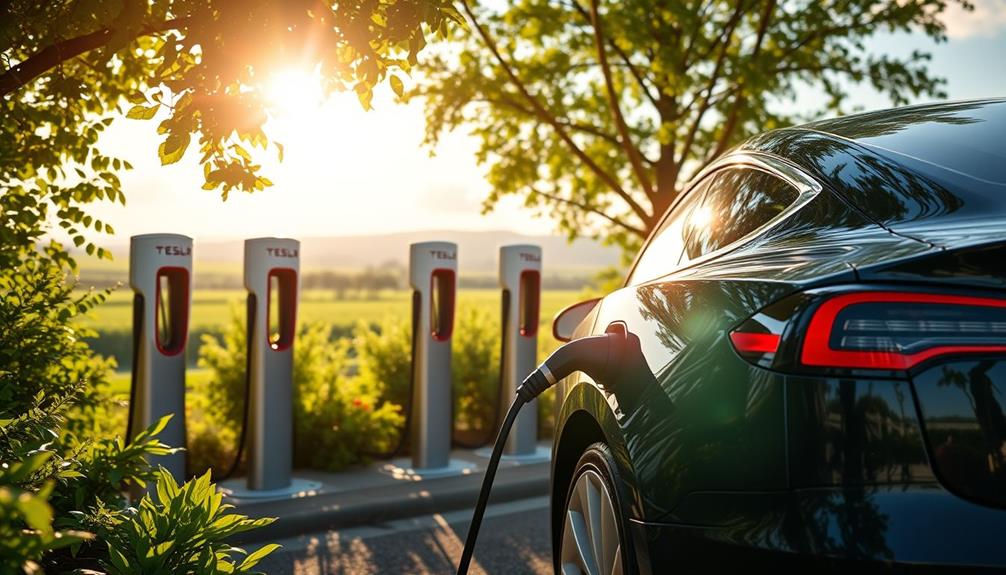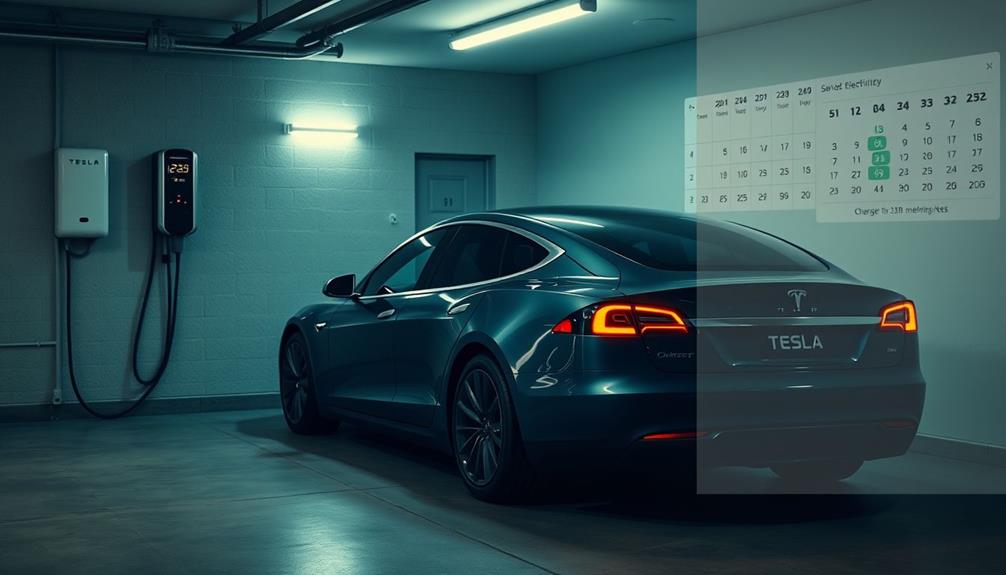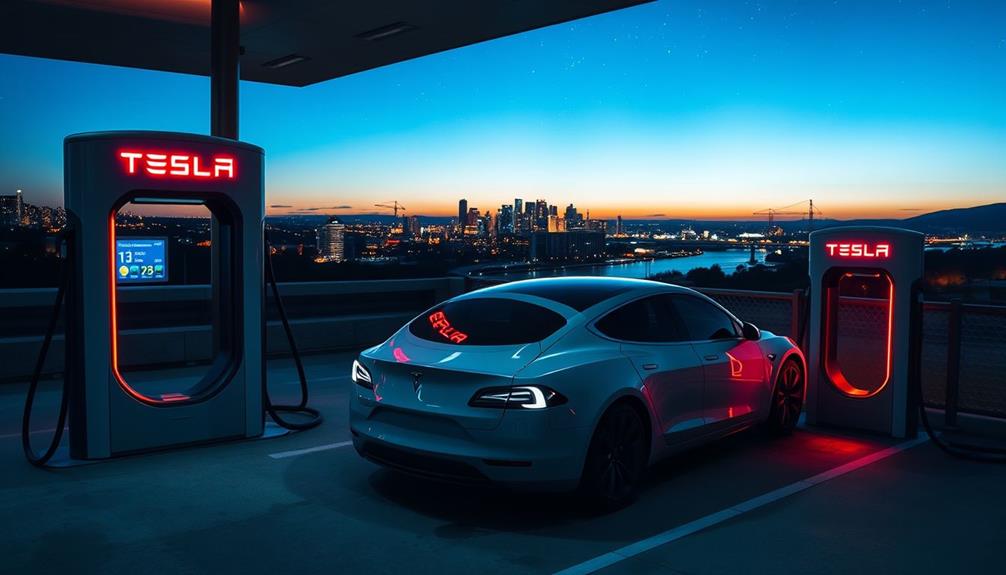Charging a Tesla does cost money, but it's usually much cheaper than filling up a gas vehicle. For example, a full charge on a Model 3 can run about $10.95, while the Model S may cost around $17.83. Depending on your driving habits and local electricity rates, monthly charging can range from $36 to $53. Plus, charging at home is generally more affordable than using Superchargers. By understanding these costs, you can plan your expenses better. If you want to discover more about charging options and potential savings, there's plenty more to uncover.
Key Takeaways
- Charging a Tesla incurs costs, ranging from $8.28 to $17.99 for a full charge, depending on the model.
- Monthly charging expenses typically range from $36 to $53, significantly lower than the average gas expense of $143.
- Home charging is the most economical option, while Supercharger rates are higher, averaging $0.25 to $0.50 per kWh.
- Installation of a Tesla wall connector can cost between $750 and $1,500, but it leads to long-term savings.
- Utilizing renewable energy sources, like solar, can reduce charging costs to as low as $0.06 per kWh.
Cost of Charging a Tesla
When it comes to charging a Tesla, you'll find that costs can vary based on several factors, including your specific model and local electricity rates. Understanding common financial terms related to energy costs can help you make more informed decisions.
The average cost to charge a Tesla Model 3 is about $10.95, while you might pay up to $17.83 for a Model S. Charging at home typically costs between $8.28 and $14.40 for a full charge, making it a more economical option compared to public charging.
However, if you opt for public charging, charging costs can rise considerably. Supercharger rates usually range from $0.25 to $0.50 per kilowatt-hour, leading to costs as high as $32.78 for a full charge on some models.
Despite these variations, Tesla owners can expect their monthly charging costs to be between $36 and $53, which is much lower than the average gas expense of around $143 for traditional vehicles.
When you break it down, the cost per mile for charging a Tesla is generally around 4.03 to 5.17 cents, making it more economical compared to the average 13.73 cents per mile for gas vehicles.
Charging Options Available

Tesla owners have a variety of charging options to keep their vehicles powered and ready for the road. Understanding these options can help you choose the best method for your lifestyle and budget. Here are three popular charging choices:
1. Home Charging: Using Level 2 chargers at home is convenient. You can expect full charge costs ranging from $8.28 to $14.40, depending on your vehicle model and local electricity rates.
For families looking for a getaway, some hotels offer unique amenities like top hotels with water parks which may include charging stations for electric vehicles.
2. Tesla Superchargers: For those on the go, Level 3 Superchargers are a fantastic option. They can recharge your Tesla to 200 miles of range in about 15 minutes.
However, be prepared to pay around $0.25 to $0.50 per kWh, which is higher than home charging expenses.
3. Public Charging Stations: Some businesses offer free charging stations. You can take advantage of these while shopping or dining, allowing you to recharge without incurring additional costs.
With these charging options, you can find the best fit for your needs, whether you prefer the convenience of home charging or the speed of Tesla Superchargers.
Home Charging Expenses

When you charge your Tesla at home, you can expect to spend between $8.28 and $14.40 for a full charge, depending on your model and local electricity rates.
It's also important to take into account the initial installation costs for your charging equipment, which can range from $750 to $1,500.
Additionally, understanding the importance of budgeting for cold medications overview can help you manage your overall expenses effectively.
With charging efficiency around 90%, understanding these expenses can help you budget effectively and maximize your savings.
Average Home Charging Costs
How much does it really cost to charge a Tesla at home? The average home charging costs can vary considerably based on your local electricity rates and the model you own.
For instance, charging a Tesla Model 3 typically costs around $10.95, while a Model S can run you about $17.83 to fully charge. Remember, charging efficiency is generally around 90%, meaning you'll need a bit more energy than the battery's capacity due to energy loss.
Additionally, just like investing in a Gold IRA, understanding your expenses can lead to better financial decisions in the long run, as evidenced by strong customer service ratings in the precious metals market.
Consider these emotional factors when thinking about your charging expenses:
- Savings: Charging at home is often less than half the cost of using Supercharger stations.
- Convenience: You can charge overnight and start each day with a full battery.
- Predictability: Your annual charging costs for driving 13,500 miles can range from $405 to $1,755, giving you a clear budget.
Equipment Installation Considerations
Before committing to a home charging solution, it's essential to weigh the costs of equipment installation against the potential savings. Installing a Tesla wall connector at home can set you back between $750 and $1,500, which includes both the equipment and installation fees.
While this might seem steep, consider that the Tesla wall connector itself costs around $450 and can provide up to 44 miles of range per hour. This efficiency drastically reduces the frequency of your charging sessions, similar to how diversifying your retirement portfolio with assets like gold can safeguard against economic volatility investment strategies in precious metals.
If you're looking for a universal charging option, you can find a compatible wall charger for about $620. While the mobile connector is a lower-cost choice, it only offers 2-3 miles of range per hour, which may not suffice for daily drivers.
Many homeowners find that the investment pays off within a year due to savings on electricity. Charging at home typically costs between $8.28 and $14.40 for a full charge, compared to gas expenses.
Ultimately, balancing the installation costs with your potential savings will help you make an informed decision about your Tesla charging needs.
Charging Efficiency Factors
Charging efficiency plays an essential role in determining your overall home charging expenses for a Tesla.
If you're evaluating how much it costs to charge your Tesla, it's important to understand that your local electricity rates and the efficiency of your charging setup can greatly impact your annual charging costs.
Additionally, just as with Gold IRAs, where understanding market trends and regulations is vital, being informed about your charging options can lead to better financial decisions.
Here are three key factors to take into account:
- Local Electricity Rates: In areas with low rates, you might spend just around $7 to charge your Tesla Model 3 fully.
- Charging Efficiency: With home charging estimated at about 90%, you'll need slightly more energy than the battery capacity.
- Public Charging Stations: Using these can double your costs, ranging from $0.25 to $0.50 per kWh.
Ultimately, if you charge your Tesla at home, you're likely to enjoy lower costs.
The average cost of electricity can lead to annual charging costs between $405 and $1,755, depending on your driving habits.
Supercharger Pricing

Tesla's Supercharger pricing can considerably impact your overall electric vehicle costs, especially for frequent travelers. When using a Tesla Supercharger, you'll typically pay between $0.25 to $0.50 per kWh, which can make charging at these stations about double the average cost of home charging.
It's worth noting that similar to avoiding gold IRA scams, properly budgeting for charging costs can prevent unexpected expenses. For example, the average cost to charge a Tesla Model 3 at a Supercharger station can range from $6.01 to $32.78, depending on your location and the time of day.
While Tesla's charging network includes around 17,000 stations, you should be aware of additional fees that can further increase your costs. Idle fees of $0.50 per minute can apply if you leave your vehicle parked at a charging station after it's fully charged.
Additionally, during peak times, congestion fees of $1.00 per minute may kick in, adding to your expenses.
Though Superchargers can add about 200 miles of range in just 15 minutes, it's crucial to examine these costs when planning your long-distance travel. Understanding supercharger pricing and potential fees can help you budget accordingly and optimize your charging strategy.
Comparison With Gas Vehicles

When you compare charging a Tesla to fueling a gas vehicle, the savings are hard to ignore.
The average cost of charging a Tesla is typically lower than the cost of gas, allowing for considerable savings over time, particularly when considering the value of home security systems as an investment in peace of mind.
You'll find that charging costs considerably less and your cost per mile drops dramatically.
Plus, maintenance on a Tesla tends to be lower, making it an even smarter financial choice.
Charging Vs. Fuel Costs
While many drivers are accustomed to the fluctuating costs of gasoline, switching to an electric vehicle like a Tesla can greatly alter your monthly expenses. You might be surprised to learn that charging an electric vehicle is generally three times cheaper than fueling a gas vehicle. Here's how:
- Cost per mile: The average cost per mile for a Tesla is about 4.56 cents, compared to 13.73 cents for gas vehicles. This notable difference allows Tesla owners to enjoy a more economical driving experience, similar to the uplifting feelings captured in Blue Skies and Lemonade.
- Monthly expenses: While the average monthly gas expense is around $143, charging costs for a Tesla range from $36 to $53.
- Annual savings: Depending on the model, annual charging costs for Tesla vehicles vary from $405 to $1,755, usually lower than annual fueling costs for gas vehicles.
For instance, a full charge for a Tesla Model 3 costs roughly $10.95, while refilling a gas vehicle can vary considerably due to average U.S. gas prices, which currently range from $3.11 to $5.10 per gallon.
Additionally, Tesla vehicles boast an impressive charging efficiency of 87-91%, ensuring more energy reaches the wheels than with traditional gas-powered vehicles.
Maintenance and Efficiency Comparison
Electric vehicles, especially Teslas, offer significant advantages in maintenance and efficiency compared to traditional gas vehicles. When you charge a Tesla at home, it typically costs between $8.28 and $14.40 for a full charge. This is substantially lower than the expenses associated with maintaining a Doomsday Robots lifestyle, which can often require more robust planning and resources.
In contrast, gas vehicles can average monthly fueling costs of around $143, making Teslas a more economical choice regarding annual charging costs, which range from $405 to $1,755 depending on the model.
With energy efficiency rates of 87-91%, Teslas convert a much higher percentage of energy to drive power compared to just 16-25% for gas vehicles. This means the cost per mile for a Tesla is about 4.56 cents, whereas gas vehicles average around 13.73 cents per mile.
Additionally, maintenance costs for Teslas are generally lower due to fewer moving parts, leading to reduced ownership expenses over the vehicle's lifespan.
Vehicle-Specific Charging Costs

Understanding vehicle-specific charging costs can help you make informed decisions about which Tesla model suits your needs best. Each model has unique charging expenses tied to its battery capacity, affecting your overall cost of ownership.
Here's a quick comparison of the charging costs for popular Tesla models:
- Model 3: $10.95 for a full charge, costing about 4.03 cents per mile with a range of 272 miles.
- Model S: $17.83 for a full charge, at approximately 4.40 cents per mile and a range of 405 miles.
- Model Y: $14.39 for a full charge, resulting in a cost of 4.75 cents per mile for a range of 303 miles.
The Model X stands out with a charging cost of $17.99, yielding 348 miles at about 5.17 cents per mile.
As you consider your options, remember that the charging costs vary considerably among the models. While the Model 3 offers the lowest charging expenses, larger models like the Model S and Model X have higher costs due to their larger battery capacity.
Choose wisely to maximize your EV experience!
Factors Impacting Charging Costs

Charging costs can vary widely based on several factors beyond just the Tesla model you choose. Your location plays a substantial role, with electricity prices ranging from as low as $0.11/kWh in Louisiana to $0.28/kWh in Massachusetts. This can greatly impact your overall expenses.
For instance, if you own a Model 3, the cost to fully charge is around $10.95, while a larger Model S will set you back approximately $17.83.
Charging at home is usually the most economical option, with average costs between $8.28 and $14.40. In contrast, public charging stations and Supercharger stations can charge between $0.25 and $0.50 per kWh, often doubling your costs. Frequent use of Supercharger stations can considerably inflate your annual charging expenses.
Additionally, factors like seasonal variations and your driving habits—such as taking frequent short trips or driving in colder climates—can lead to increased charging frequency and costs.
Understanding these factors impacting your charging costs can help you make informed decisions about your Tesla ownership.
Benefits of Renewable Energy

Harnessing renewable energy, particularly solar power, offers significant financial benefits for Tesla owners. By utilizing solar panels, you can drastically reduce the costs associated with charging your electric vehicle (EV). Charging your Tesla using solar energy can cost as little as $0.06 per kWh, compared to typical grid rates that are often much higher.
Consider these compelling advantages:
- Long-term savings: After an average ROI of 7-8 years, you can charge your Tesla for free, given that solar panel systems last 25-30 years.
- Reduced carbon footprints: Using renewable energy helps decrease greenhouse gas emissions, contributing to a healthier planet.
- Community solar initiatives: These often provide lower annual costs, making renewable energy even more accessible and economical for EV owners.
Frequently Asked Questions
How Much Does It Cost to Fully Charge a Tesla at a Charging Station?
Charging your Tesla at a station typically costs between $6 and $50, depending on location and model. The Model 3 averages around $10.95 per full charge, while idle fees can increase your total expense.
Is Charging Your Tesla at a Charging Station Free?
Charging your Tesla at a station isn't free. You'll usually pay between $0.25 and $0.50 per kWh. While some places may offer complimentary charging, it's not a common perk for all Tesla owners.
Is It Cheaper to Charge a Tesla at Home or Supercharger?
Think of charging a Tesla like filling a bathtub. Home charging slowly fills it at a fraction of the cost, while Superchargers blast water in quickly, but they drain your wallet much faster. Choose wisely!
How Do Tesla Charging Fees Work?
Tesla charging fees vary based on location and charging method. At home, you pay a flat rate per kWh, while Superchargers charge per kWh, plus potential idle and congestion fees during peak times.
Conclusion
So, does charging a Tesla cost money? Absolutely, but it's not as intimidating as it seems. While you'll pay for electricity, the overall savings compared to gas vehicles can be significant. Plus, if you opt for renewable energy sources, you could charge your Tesla for even less—maybe even for free! As you plunge into the world of electric vehicles, you'll find that the true costs are often lower than you'd expect, making it a smart choice for your wallet and the planet. When considering Tesla charging costs, it’s important to factor in the potential savings from reduced maintenance and tax incentives. With fewer moving parts, electric vehicles like Tesla require less maintenance, saving you money in the long run. Additionally, there may be tax incentives or rebates available for purchasing an electric vehicle and installing a home charging station, further offsetting the initial costs. Overall, the investment in a Tesla and its charging costs can pay off in more ways than one.









